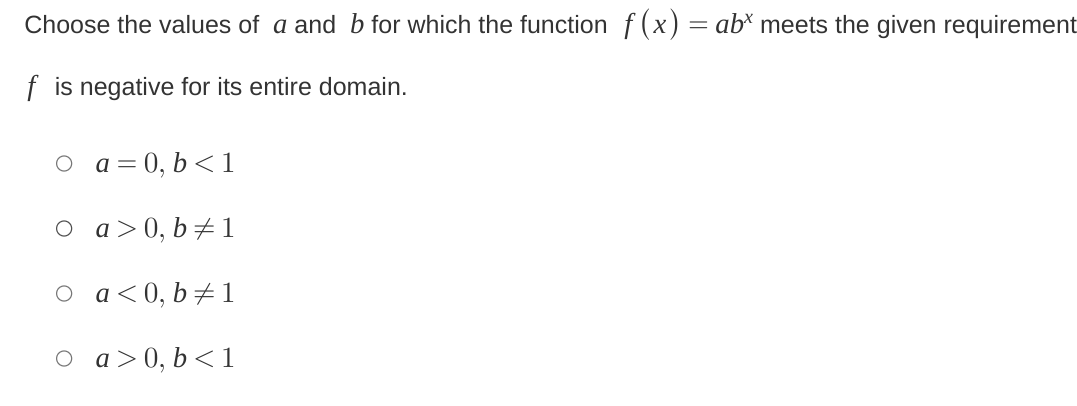Choose the values of a and b for which the function f(x) = ab^x meets the given requirement that f is negative for its entire domain.

Understand the Problem
The question is asking to identify the values of 'a' and 'b' such that the function f(x) = ab^x is negative for all values in its domain. This involves understanding the behavior of exponential functions based on the parameters a and b.
Answer
The values are \( a < 0 \) and \( b \neq 1 \).
Answer for screen readers
The correct values are ( a < 0 ) and ( b \neq 1 ).
Steps to Solve
-
Understanding the function behavior The function ( f(x) = ab^x ) is an exponential function. The sign of ( f(x) ) depends on the values of ( a ) and ( b ).
-
Analyzing the role of 'a' For ( f(x) ) to be negative for all ( x ), ( a ) must be negative. If ( a > 0 ), then ( f(x) ) will never be negative. If ( a = 0 ), then ( f(x) = 0 ) for all ( x ), which is not negative.
-
Analyzing the role of 'b' The base ( b ) must be a positive number such that the function is defined for all real ( x ). Valid choices for ( b ) include ( 0 < b < 1 ) (which results in a decaying function) or ( b > 1 ) (which results in a growing function). However, regardless of whether ( b ) is greater than or less than 1, the sign of ( f(x) ) is still determined by ( a ).
-
Conclusion on possible values From the analysis, the only way for ( f(x) ) to always be negative is if ( a < 0 ) (to ensure the product is negative) and ( b \neq 1) (to ensure that ( f(x) ) is defined for all ( x )). Choices like ( a > 0 ) or ( b = 1) would result in ( f(x) ) being non-negative in certain cases.
The correct values are ( a < 0 ) and ( b \neq 1 ).
More Information
In exponential functions, the parameters ( a ) and ( b ) play a crucial role in determining the function's behavior. A negative ( a ) ensures the function remains below the x-axis, while ( b ) must be a positive value to keep the function defined.
Tips
- Assuming ( a = 0 ) leads to ( f(x) = 0 ) instead of a negative function.
- Misunderstanding that ( b ) must be a positive number, which limits choices to ( b < 1 ) or ( b > 1 ), but never negative.
AI-generated content may contain errors. Please verify critical information